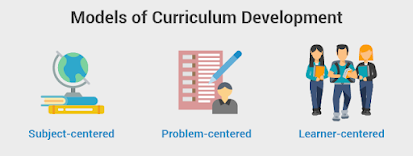- Get link
- X
- Other Apps
Curriculum development models
Curriculum development models provide a structured framework for educators to design and implement effective learning experiences. These models help ensure that the curriculum aligns with educational goals, student needs, and desired learning outcomes. There are several popular curriculum development models, each with its own strengths and weaknesses:
1. Subject-Centered Design
- Focuses on a particular discipline or subject area, like math, science, or literature.
- Content and knowledge are prioritized, ensuring students gain a strong foundation in the subject.
- This traditional approach might not fully consider individual student needs or interests.
2. Learner-Centered Design
- Places students at the center, focusing on their interests, needs, and goals.
- Encourages active participation and promotes the development of critical thinking and problem-solving skills.
- May require more flexibility from educators and can be challenging to implement in large classrooms.
3. Problem-Centered Design
- Presents students with real-world problems or scenarios to grapple with.
- Encourages students to develop critical thinking, research, and collaboration skills as they seek solutions.
- Requires careful selection of problems that are age-appropriate and relevant to the curriculum.
Choosing the Right Model
The most suitable curriculum development model depends on various factors, such as:
- Educational goals and desired learning outcomes
- Student needs and interests
- Subject matter and content
- Available resources
- Instructional approaches
Educators can also combine elements from different models to create a hybrid approach that best suits their specific context.
Here are some additional points to consider:
- Curriculum development models are cyclical, meaning they can be revisited and refined over time.
- They should be adaptable to accommodate changing needs and educational trends.
- Effective curriculum development involves ongoing evaluation to ensure the curriculum is achieving its intended outcomes.
Delving Deeper into Curriculum Development Models:
Here's a more detailed breakdown of the three curriculum development models you mentioned, along with examples to illustrate their application:
1. Subject-Centered Design:
- Definition: This traditional model prioritizes a specific subject area and its core knowledge base. The curriculum is built around established disciplines like mathematics, history, or language arts.
- Strengths:
- Ensures a strong foundation in core subjects.
- Provides a clear structure and sequence for learning.
- Often aligns with standardized testing requirements.
- Weaknesses:
- May not cater to individual student interests or learning styles.
- Can be teacher-centered, with less emphasis on student participation.
- Example: A high school biology curriculum might focus on core topics like cell structure, genetics, and evolution. The lessons would involve lectures, textbook readings, and lab experiments designed to teach these fundamental biological concepts.
2. Learner-Centered Design:
- Definition: This model flips the script, placing students at the heart of the
curriculum. It emphasizes student needs, interests, and learning styles. - Strengths:
- Boosts student engagement and motivation.
- Promotes critical thinking, problem-solving, and self-directed learning.
- Can cater to diverse learning styles and abilities.
- Weaknesses:
- Requires more flexibility and adaptability from teachers.
- May be challenging to implement in large classrooms with limited resources.
- Example: A middle school language arts class might involve student-chosen book projects. Students research topics they're passionate about, select books on those subjects, and then present their findings to the class. This approach allows students to delve into areas of personal interest while developing critical thinking, research, and presentation skills.
3. Problem-Centered Design:
- Definition: This model presents students with real-world problems or scenarios to grapple with. The focus is on the process of solving these problems, encouraging critical thinking, collaboration, and research skills.
- Strengths:
- Makes learning relevant and engaging by connecting it to real-world issues.
- Develops problem-solving, collaboration, and research skills.
- Encourages students to think creatively and find solutions.
- Weaknesses:
- Requires careful selection of problems that are age-appropriate and relevant to the curriculum.
- May not provide a strong foundation in core subject areas if not carefully designed.
- Example: A high school environmental science class might tackle the issue of water pollution in their local community. Students would research the causes and effects of pollution, design solutions, and then present their findings and proposed solutions to the local government. This approach integrates science concepts with critical thinking, collaboration, and civic engagement.
Remember, these models are not mutually exclusive. Educators can draw on elements from each model to create a hybrid curriculum that best suits their specific needs and learning goals.
References
I can offer some helpful resources for further reading on curriculum development models:
- Books: You can find numerous books on curriculum development at your local library or online retailers. Here are a few suggestions:
- "Curriculum Development and Design" by Glatthorn, A.A., & Collinson, J. (2002) [This is a classic text in the field]
- "Understanding by Design" by Wiggins, G., & McTighe, J. (2005) [This book focuses on a backward design approach to curriculum]
- Websites: Educational websites often provide information on curriculum development. Here are a couple of reputable sources:
- Association for Curriculum Development & Supervision https://www.ascd.org/
- Curriculum Development and the 3 Models [+ Free Course Plan Template] | Top Hat https://tophat.com/
- Books: You can find numerous books on curriculum development at your local library or online retailers. Here are a few suggestions:
Comments


Nice hijab 😍
ReplyDeleteG shukriaaaa
DeleteInteresting☺
ReplyDelete